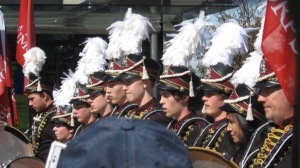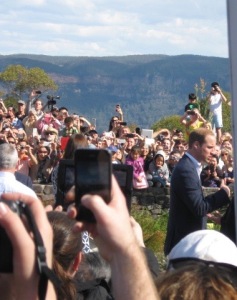I’m not sure if I believe this yet. A few days ago the University of Sydney advised me I have now satisfied the requirements for the award of the degree of Doctor of Philosophy (Arts & Social Sciences). I don’t think I will really believe it until that day arrives when I am in the Great Hall, suitably robed in the black and scarlet gown and hood, being conferred with the degree by the Chancellor of the University.

The Town Band welcomes the Duke and Duchess of Cambridge to Katoomba, in the Blue Mountains, 17 April 2014. Photo mrbbaskerville.
My thesis is titled The Chrysalid Crown: An un-national history of the Crown in Australian 1808-1986. Click on the title to view a copy.

The Duke and Duchess of Cambridge somewhere in the crowd, Katoomba, 17 April 2014. Photo mrbbaskerville.
This is the abstract of the thesis, recorded in the university library system, if you don’t have the time to while away on 80,000 words plus appendices.
This thesis set out to answer a deceptively simple question: why did the 1999 referendum to abolish the Australian Crowns fail? It focuses on the evolving civic personalities, communal identities and popular representations of the Crown in Australia, and how those representations and agents changed over 180 years. Capacities for the Crown’s continuing mutability, especially its divisibility, are at the heart of these imaginings. The answer to the question lies partly in emotions, in passion and the heart rather than in reason and the mind, along with a complex historical mix of other factors. Each chapter focuses on a single event or artefact: a usurpation of vice-regal authority, a proposal for a cadet kingdom of Australia, a mystic royal response to anti-German persecution, a State’s attempt to secede under the Crown and the invention of a chivalric order. The thesis posits a complex, iterative and changing network of social relationships rather than a simple metropole-periphery binary or hierarchy. It disaggregates ideas of crown, Britishness, empire, nation and Australianess, and concludes on the eve of the 1988 bicentennial celebrations when the Crown in Australia appeared splendid, popular, modern, federal, natural and regenerative. They were characteristics that, with hindsight, girded an Australian institution at once ancient and contemporary for the challenges of the 1990s when it stared-down what appeared to be an existential threat from Australian republicanism.



Congratulations Bruce! Your abstract reveals a thesis with a fascinating focus on a nuanced history of the emotions about a topic that is both untrendy but highly relevant for our current affairs. I also think about the concerns expressed about the trend of many PhDs on an incredibly limited time frame. Your view of 180 years would allow you to analyse the more profound historical processes behind a variety of events.
LikeLike
Thanks Yvonne, I like the combination of detail and long time span, I think it is needed to try and discern long-term trends or underlying continuities (or their absence). I used a modified version of Alan Atkinson et al’s slice approach from the 1980s to cover that much time, also rather untrendy, but it did allow for commonalities between otherwise seemingly disconnected events to be made visible. Not sure my examiners were entirely persuaded by the approach, as they kept calling the slices ‘case studies’, although one wrote “it is hard to see how such a large thesis could be substantiated or sustained unless tackled over the longue duree … the author cumulatively thickens his case as he proceeds, and by the conclusion it is a weighty and convincing thesis”. Now I’m struggling a bit trying to keep up with requests too give talks about it, off to Wagga next week for another one!
LikeLike
And those comments from the examiners are why too many theses are focused on tiny time scales and thus the longer time-scale time period which could reveal profound historical processes are not tackled in PhD theses. This is a shame. For all that historians laud the Annales approach, examiners of PhDs do not support it in their marking and comments
I have been thinking about these issues with respect to what I am currently working on. To do my topic properly I have decided I must look at the time-frame of an average human life ie ~70 years, in order to properly understand the historical processes I am examining. That is not a long time-frame, but it is way better than the myopic focus on the four years of WWI that pervades too many histories.
Your abstract has really given me heart and more confidence in my approach. And yes, my inspiration has also been Alan Atkinson’s approach.
LikeLike